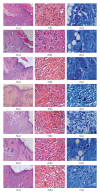Wound Healing Activity of Rubus sanctus Schreber (Rosaceae): Preclinical Study in Animal Models
- PMID: 19755505
- PMCID: PMC3139958
- DOI: 10.1093/ecam/nep137
Wound Healing Activity of Rubus sanctus Schreber (Rosaceae): Preclinical Study in Animal Models
Abstract
Young shoots of Rubus species have been used for healing of wounds, infected insect bites and pimples in folk medicine for ages. In order to evaluate the wound healing activity of Rubus sanctus, four different extracts were prepared from the whole aerial parts of the plant by using n-hexane, chloroform, ethyl acetate and methanol, respectively. Incision wound healing model by using tensiometer on rats and excision model on mice were employed to assess the activity. Remarkable wound healing activity was observed with the ointment formulation of the methanol extract at 1% concentration on the mentioned models. The results of histopathological examination also supported the outcome of both incision and excision wound models. The wound healing effect was comparatively evaluated with a reference ointment Madecassol. The experimental data confirmed the ethnobotanical usage of R. sanctus.
Figures




References
-
- Jouad H, Maghrani M, Eddouks M. Hypoglycaemic effect of Rubus fructicosis L. and Globularia alypum L. in normal and streptozotocin-induced diabetic rats. Journal of Ethnopharmacology. 2002;81(3):351–356. - PubMed
-
- Marquina MA, Corao GM, Araujo L, Buitrago D, Sosa M. Hyaluronidase inhibitory activity from the polyphenols in the fruit of blackberry (Rubus fruticosus B.) Fitoterapia. 2002;73(7-8):727–729. - PubMed
-
- Panizzi L, Caponi C, Catalano S, Cioni PL, Morelli I. In vitro antimicrobial activity of extracts and isolated constituents of Rubus ulmifolius . Journal of Ethnopharmacology. 2002;79(2):165–168. - PubMed
-
- Patel AV, Rojas-Vera J, Dacke CG. Therapeutic constituents and actions of Rubus species. Current Medicinal Chemistry. 2004;11(11):1501–1512. - PubMed
-
- Guarrera PM. Traditional phytotherapy in Central Italy (Marche, Abruzzo, and Latium) Fitoterapia. 2005;76(1):1–25. - PubMed
LinkOut - more resources
Full Text Sources

